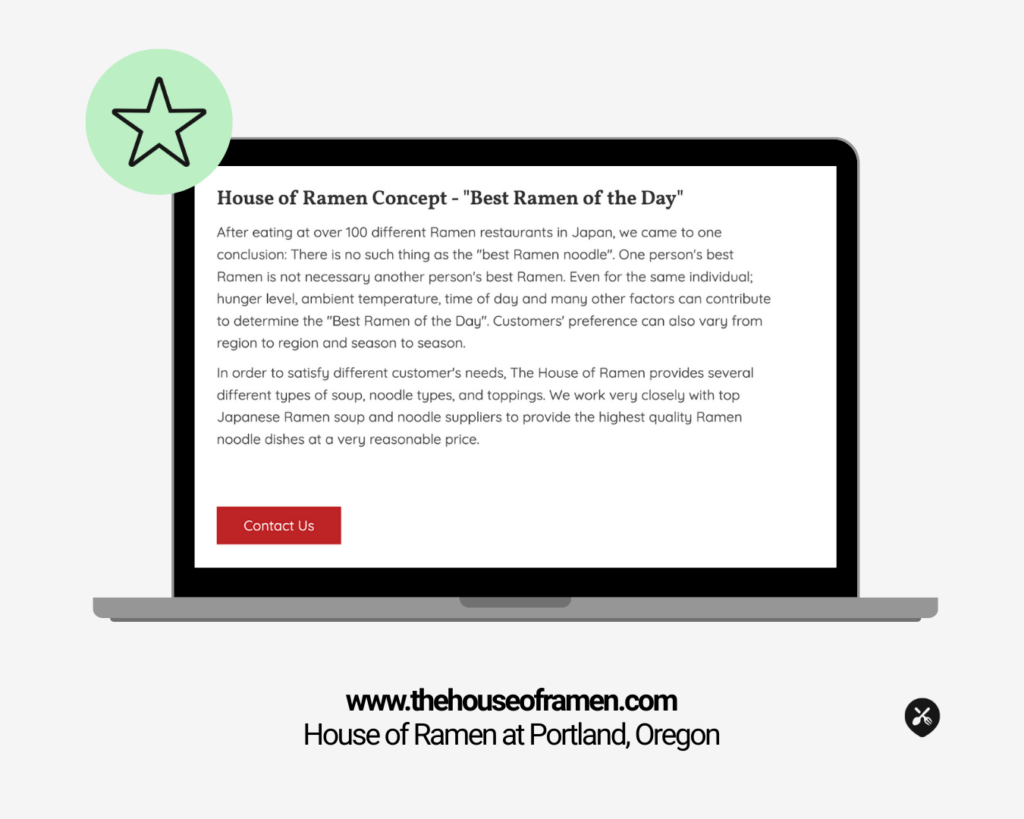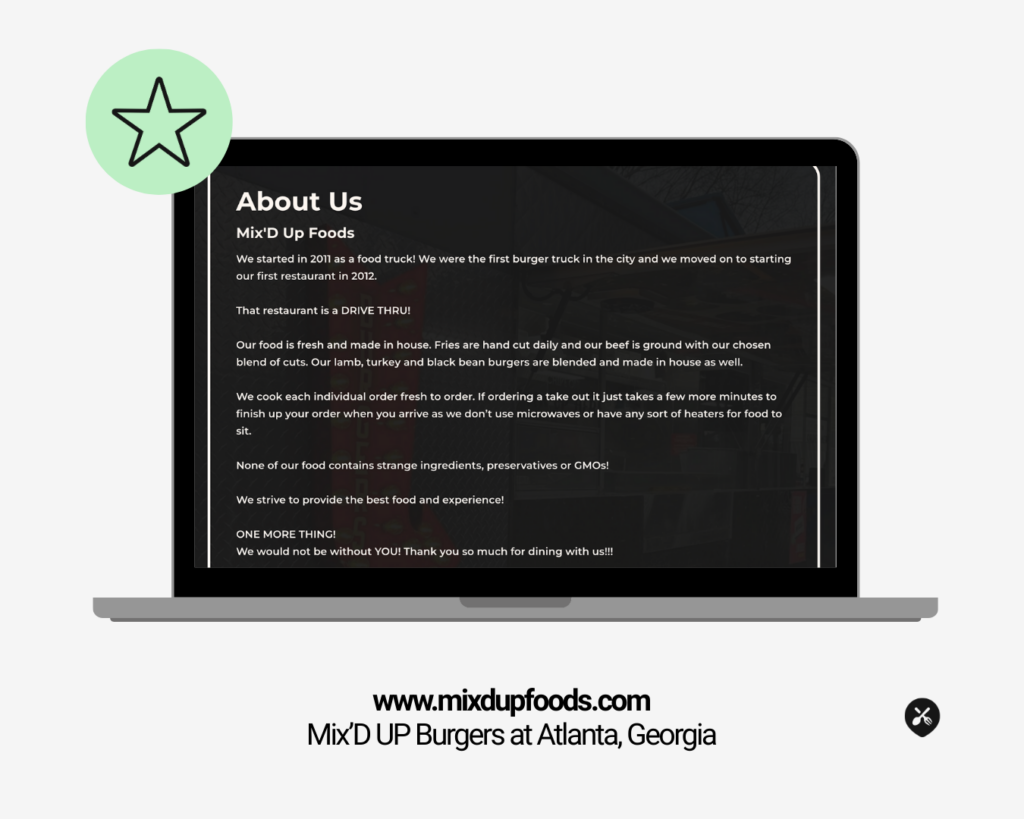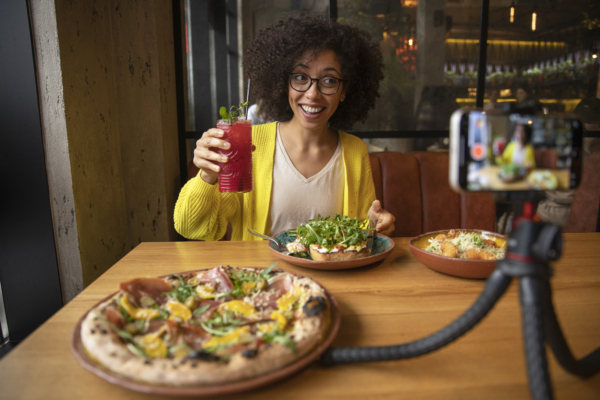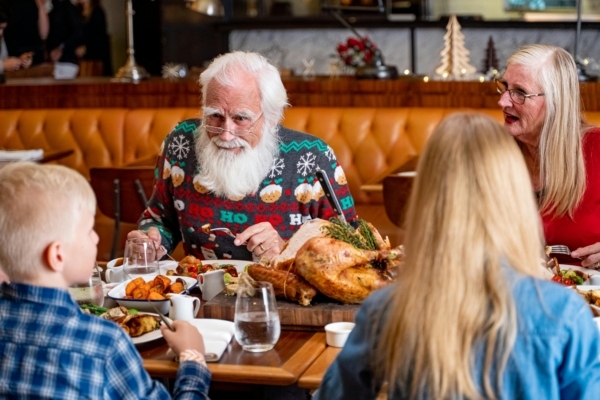How to Write a Restaurant Description for Your About Us Page (With Examples)

A restaurant About Us page is your story in one place: who you are, what you serve, and why your restaurant exists.
Think of it as a handshake with potential guests, a first impression that says, “Here’s who we are, what we serve, and why it matters.”
In this article, you will learn:
- How to write a compelling restaurant description for your About Us page
- Where to use your restaurant About Us to get more visibility
- What details make your restaurant memorable to new customers and loyal patrons
What Is a Restaurant Description (and How Does It Power Your About Us Page)?
A restaurant description is the foundation of your brand online. For many diners, it’s the first introduction to your food, your values, and your personality. Instead of treating it like a checkbox, use it to tell a genuine story that helps customers feel welcome and keeps them engaged long after their first visit.
An About Us page also strengthens SEO by incorporating keywords like your cuisine, location, and signature menu items. Search engines use these signals to put your restaurant in front of people actively looking for what you serve.
How a Restaurant Description Builds Brand Identity
Think of your restaurant description as your elevator pitch. It should explain not just what you do, but why you do it. Sharing your origin story, whether it’s family recipes passed down through generations or a career pivot into your dream concept, helps define your brand’s energy and personality.
When diners understand the story behind your restaurant, they see more than menu items; they see a purpose worth supporting.
How a Restaurant Description Helps You Welcome New Customers
People want good food, but they remember connection. A confident restaurant description shows your values, your atmosphere, and why dining with you feels special.
Do Restaurant Descriptions Improve SEO?
Yes. A restaurant About Us page supports local search results when it includes keywords in your restaurant website like your cuisine, city, and popular menu items. This signals to search engines what you offer and improves your chances of showing up when hungry people search nearby.
Also adding internal links to resources like your restaurant branding guide or menu creation guide give Google even more context.
For best results, follow these tips to improve your SEO with a well-crafted restaurant description.
How a Restaurant Description Differentiates You From Competitors
Customers have a near-endless number of restaurant options available to them, and to stand out in a sea of choices, a well-written and fun About page could be the deciding factor in making your restaurant’s story engaging and memorable.
Whether you’re known for having the best Italian food, a legendary chicken sandwich, your restaurant special, or your use of sustainable ingredients, your About page helps customers choose you over other food establishments.
Now, let’s learn the first critical step to writing your About Us page, creating a powerful restaurant description.
How Do You Write a Restaurant Description for Your About Us Page?
To write a strong About Us page, you first need to start with a well-crafted restaurant description. This is the short paragraphs that explain who you are, what you serve, and why your restaurant exists.
The following steps are helpful tips for writing effective restaurant descriptions.
1. Understand Your Target Audience
To write an effective description, start by understanding your reader and what will spark their interest. Identifying your target audience is crucial, as it allows you to tailor your messaging and restaurant description to the specific group you want to attract. Your tone and messaging should reflect the people who walk through your door, or the ones you’re trying to attract.
A casual neighborhood spot will use different language than a fine-dining restaurant trying to earn a Michelin star.
2. Share Your Story and Highlight the Dining Experience
This is the emotional core of your description and how customers make a deeper connection with your business.
What inspired you to start your restaurant? Reflect on your beginning—how the company started, perhaps as a small idea or a seasonal venture, and how it grew from there. Before sharing your story with your audience, it’s important to know your own journey and values, so you can communicate them authentically. If your journey began by preparing every dish from scratch, highlight this commitment to homemade quality and craftsmanship.
If you started from humble beginnings, say so. Explaining the founders’ journey as friends can make your story more relatable. People love a success story, and knowing they’re participating in keeping your dream alive will build more loyal customers.
For example, House of Ramen shared what drives them to make noodles every day, sharing stories that bring their restaurant’s life to the forefront.

3. Feature Signature Menu Items and Quality Ingredients
Give people a clear picture of what it’s like to eat at your restaurant by highlighting the memorable meal and the fun atmosphere you offer. Use descriptive language and visuals so readers can see the unique aspects that make your restaurant stand out.
Mention stand-out menu items, maybe it’s your wood-fired pizza or your locally sourced produce, your regulars won’t stop talking about. Emphasize your commitment to authentic recipes and ingredients to ensure guests enjoy a truly authentic dining experience. Talk with your suppliers to create unique dishes that set your restaurant’s experience apart.
For example, Rendezvous in Memphis shares why their dry rub ribs have been famous for over 75 years.

4. Match Tone and Voice to Your Brand
A good restaurant description reads the same way your space feels. If your staff wears flannel and serves craft beer, don’t write like a PR firm—let your tone be fun if that matches your restaurant’s vibe and atmosphere.
If you run a sleek, intimate dining room, keep the tone polished and tight.
Use natural language, but make sure it reflects the service and vibe diners can expect when they walk in.
5. Keep It Concise and Aim For 150 to 250 Words
Avoid telling your whole business journey. It can be tempting to share every detail, but it’s not a memoir—it’s a story-driven sales pitch.
Focus on what matters. Even in a short description, make sure to include the key points that set your restaurant apart.
Who are you?
What do you serve?
What’s your point of view?
If you can write something that hits those notes in a few short paragraphs, you’ve already done more than most.
Tight writing keeps people engaged—and makes your copy easier to repurpose across your website, socials, and review platforms.
Think of it as a snapshot, not a novel.
For example, this About Us by Mix’D Up Foods is just over 150 words.
Where to Use a Restaurant Description for Maximum Impact
Now that you’ve written a tight, thoughtful description, it’s time to put it to work by sharing it across your site and homepage.
Your description should work like a flexible building block, ready to be repurposed across web platforms where your diners discover, compare, and decide where to eat. Adding it to multiple online platforms increases your visibility and helps engage more potential customers. Publishing it on your web platforms ensures important information is accessible to potential customers.
Here are the best places to use it.
From Restaurant About Us Pages to Online Ordering Platforms
The About page is the obvious home base for your description, and it should be featured prominently on your homepage and throughout your site. But it shouldn’t read like an afterthought.
Use your restaurant’s About Us page to introduce your restaurant’s values, your perspective, and what diners can look for when they walk through the door. Including important information about your restaurant’s story is helpful for visitors, as it creates a connection and encourages them to learn more.
Keep it skimmable and visually easy to navigate, especially on mobile.
Using Your Description Across Social Media,
Your short bio is prime real estate. Use a pared-down version of it here that is something punchy, with a clear hook. Looking at description examples can help inspire effective social media bios that capture your restaurant’s identity. Consider sharing a post featuring your description on social media to attract more attention and engagement once your bio is published.
Think of it as your one-sentence pitch to people scrolling quickly.
On Google Business Profile and Review Sites (Yelp, TripAdvisor)
Most people will Google your restaurant before they ever visit your website. In fact, more than 70% of diners visit a restaurant’s website before deciding where to dine, making it crucial to have an engaging and informative online presence.
To make the best impression, log in to your business account and update your published restaurant descriptions with a clear, engaging summary that reflects your brand. Be sure to mention online ordering options in your description, as this highlights convenience and can attract more customers looking for takeout or delivery.
This helps your restaurant show up in relevant search engines, and it makes people more likely to click through.
For example, Emporium Thai has a great version of this on their restaurant on Google Business Profile.
Menus, Table Signage, and In-Store Materials
A pared-down version of your description works great in print, especially when you highlight your meal offerings to give diners a taste of what to expect. Including a brief description of a signature menu item can entice diners and help them make a decision.
A sentence or two at the top of your menu, a note on a table tent, or a paragraph in your takeout packaging all provide guests with more context and create a more personal connection.
Press Kits and Partnership Material
Journalists and collaborators (influencers, other local businesses, etc) often need a fast way to understand your restaurant.
Your published description should be ready to drop into emails, pitches, press kits, and media requests without needing edits. Be sure to highlight your restaurant’s key selling points—such as menu highlights, unique ambiance, or exceptional customer service—in these materials to make your establishment stand out.
If you’ve already nailed the tone on your restaurant website, it’ll carry through here too.
Restaurant Description Examples in About Us Pages That Work
Looking for more inspiration? Here’s how real restaurants are using their About Us pages to make lasting connections. In these examples, describing menu items and the dining experience in vivid detail proves highly effective in engaging customers and boosting interest.
1. Tell a Genuine Story
Restaurants that share their origin create an emotional hook. These stories show passion, grit, and what makes the restaurant worth supporting.
For The Dinner Bell, their About Us page shares the restaurant’s humble beginnings and its proud reopening. This is proof that a great story can be your most valuable marketing tool. The warmth and resilience of their journey help guests connect emotionally before they even step inside.
Pro tip: Don’t be afraid to get personal. People remember stories more than menus.
2. Highlight Quality Ingredients
Talk about your food philosophy! If you source locally, use farm-fresh produce, or have a signature house-made sauce, say so. Consider your customers’ needs—understanding what matters most to them can help you decide which details to highlight. These details make you stand out and help customers feel good about dining with you.
For King & Cardinal, they proudly call out their 100% halal menu, showcasing their commitment to both food quality and cultural authenticity. It’s a simple but powerful way to build trust with target audiences looking for values-aligned businesses.
3. Use High-Quality Photos and Honest Language
People eat with their eyes first. Strong visuals paired with authentic, friendly language instantly build credibility and draw people in.
For China Spring, their About page features real photos of their food and not stock images. The honest, straightforward tone feels inviting and sincere, giving potential guests a glimpse of what to expect.
Pro tip: Show the people behind the plate. Add behind-the-scenes shots, staff photos, or a short timeline to bring your story to life.
4. Focus on Connection, Not Just Info
When you center your story, values, and what makes you different, you’re not just informing—you’re building trust and loyalty. That’s what keeps customers coming back.
For TXG’s Cheesesteaks, their About Us page is a love letter to family legacy, bridging Italy and the USA in a story of resilience and purpose. It shows how food can connect generations and cultures—something that resonates far beyond the plate.
Pro tip: Use your About page to tell people why you do what you do, not just what you serve.
How Can You Focus on What Makes Your Restaurant Unique and Turn It Into Selling Points?
Sometimes the strongest selling points are already written in your restaurant’s own words. An About Us page captures your values, your story, and your personality — and when paired with data-driven results, it shows not just who you are, but why guests should keep coming back.
Here are some examples of how partner restaurants have turned their About Us descriptions into powerful selling points that drive loyalty and repeat orders:
1. Atchana’s Homegrown Thai highlights community and authenticity
Atchana’s About Us calls them “Coconut Grove’s coolest culinary adventure,” emphasizing local herbs, reclaimed wood, and partnerships with South Florida farms. Their case study shows how this authentic, community-driven story translates into stronger guest loyalty.
Why it works: They focus on what makes them unique — authenticity, sustainability, and neighborhood pride — turning values into clear selling points.
2. Siciliano’s Pizzaria proves the power of reviews
Siciliano’s describes themselves as a family-owned pizzeria with roots going back to 1983: “Many nights were spent in the Siciliano’s kitchen developing the perfect pizza recipes that you know and love today. All of our recipes are from our own family, and we couldn’t have made it without the loyal customers that have been coming back for years.” Their case study shows how this family tradition, paired with customer reviews about easy online ordering, saves them over $10,200 annually in third-party fees.
Why it works: Their About Us blends history, family tradition, and customer loyalty. The case study proves those values also drive measurable business results.
3. 4Top Hospitality shows scale with ownership and care
4Top Hospitality describes itself as “an employee-owned, multi-concept independent restaurant group with 16 locations across the Southeast.” Their About Us emphasizes growth from neighborhood Italian spots like Amerigo to fine dining concepts like etch, all backed by an employee ownership model launched in 2022. Their case study shows how these values translate into commission savings and sustainable growth.
Why it works: The About Us blends scale with authenticity. Highlighting employee ownership turns their values into clear selling points that set them apart.
Restaurant Description Frequently Asked Questions
How do I write a restaurant description?
Start with your story. A good restaurant description highlights who you are, what makes you special, and the dining experience you offer. Keep it simple, use clear keywords like your cuisine or location, and aim for 150 to 250 words.
Where should I use my restaurant description?
Use it everywhere people find you online. Add it to your About Us page, website homepage, social media profiles, Google Business Profile, and review sites. A short version also works on menus or press kits.
What’s the difference between a restaurant description and an About Us page?
A restaurant description is short and simple—your elevator pitch. The About Us page is longer, sharing your full story, important details, and special highlights like team photos or milestones.
Does a restaurant About Us page improve SEO?
Yes. Google looks for fresh, keyword-rich content. Adding your story, menu items, and location improves your chances of showing up in search. Internal links to other important pages also help.
How often should I update my restaurant description?
Review it at least once a year. Update it anytime you launch new dishes, change your menu, or shift your brand story. A fresh description signals to Google that your content is current.
The Right Description Can Build a Real Connection
Just like meeting someone for the first time, you want to make a good impression. When guests feel connected to your story, they’re more likely to become regulars. A thoughtful About Us page doesn’t just inform, it builds loyalty and trust.
Contact ChowNow to learn how a Restaurant Website with customizable templates can help you showcase your brand, tell your story, and turn website visitors into loyal customers.







